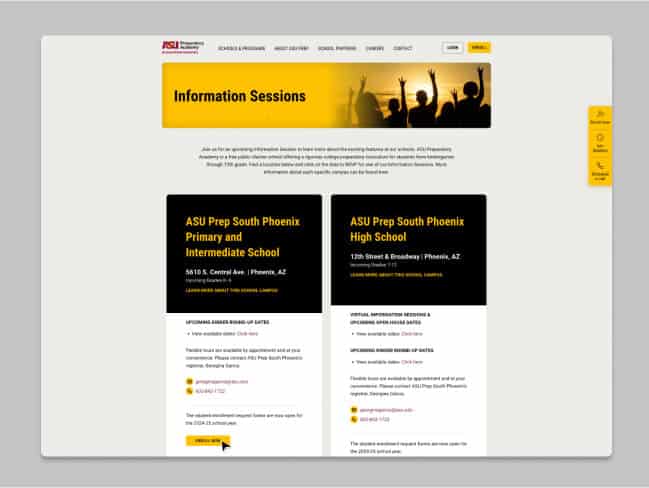So, you’ve made the decision to enroll your student in online school. Congratulations—it’s a step toward providing them with a flexible and personalized learning experience. By embracing online learning, parents/guardians and students alike gain access to a wealth of resources and opportunities tailored to individual needs and preferences.
Online education has transformed the landscape of public, private, and homeschooling, offering a wide array of benefits for students of all ages, from elementary and middle school to high school. Did you know that as of 2021, about 9.4 million students in the United States were enrolled in online courses? This highlights the growing popularity and effectiveness of online schooling as a viable alternative to traditional brick-and-mortar education.
With more parents/guardians seeking flexible learning options for their students, online school provides a solution that meets the diverse needs of students across the country and helps tailor a personalized special education suited for your student. Whether it’s the flexibility to learn from anywhere, the ability to access a wide range of courses and resources, or the opportunity for individualized instruction, online education offers unparalleled advantages for students at every stage of their academic journey.
Understanding the basics of online school

Before diving into the enrollment process, it’s essential to grasp the fundamentals of online schooling. You might be wondering, how does online school work? In online school, students have the ability to learn from anywhere, whether it’s from the comfort of home or while traveling.
There are various types of online schools available, including public school, private school, homeschool, and charter school options, each offering different curriculum choices and instructional approaches. Additionally, online programs may be fully virtual or hybrid, combining online instruction with in-person components.
Understanding the scheduling options is crucial, as online schools may offer synchronous learning, where students attend live classes at scheduled times, or asynchronous learning, allowing students to access course materials and complete assignments at their own pace.
In addition, online education requires certain technology requirements, such as a reliable internet connection, computer or tablet, and access to learning platforms and software. Ensuring that these technology needs are met is essential for a smooth online learning experience.
Finally, parents/guardians should consider the curriculum and accreditation of the online school to ensure that it meets their student’s academic needs and standards. By understanding the basics of online school, parents/guardians can make informed decisions when enrolling their student in an online program.
Benefits of online learning for students

Online school offers a multitude of benefits for students across all grade levels. One of the most significant advantages is flexibility. Online education allows students to customize their learning schedules, accommodating other commitments such as extracurricular activities or family responsibilities. This flexibility fosters a healthy balance between education and other aspects of life, promoting overall well-being and mental health.
Online learning also provides exclusive learning paths tailored to each student’s needs. With an adaptable curriculum and individualized attention, students can progress at their own pace, ensuring mastery of concepts before moving on to new material. Moreover, online schools offer access to a diverse range of courses, including specialized subjects and opportunities for advanced learning. This variety allows students to explore their interests and pursue areas of study that align with their passions and future aspirations.
Finally, online school promotes the development of digital literacy skills, preparing students for success in a technologically driven world. By navigating online platforms and engaging with digital resources, students gain valuable skills that are essential for their academic and professional growth.
Choosing the right online school

When considering how to switch from in person to online school, selecting the right institution is crucial for the student’s academic success and overall experience. One key consideration is accreditation and recognition. It’s essential to ensure the online school is accredited by recognized institutions, verifying its credentials and legitimacy. Accreditation guarantees that the school meets rigorous standards of quality and adheres to established educational practices.
Another important factor to consider is the curriculum and instructional quality. Evaluate the curriculum standards to ensure they align with your student’s educational goals and preferences. Additionally, assess the qualifications of the teaching staff and the availability of support services, such as tutoring, counseling, or an individualized education program (IEP).
Social interaction and extracurricular activities also play a significant role in the online learning experience. Look for online schools that offer opportunities for student engagement, including virtual clubs, sports teams, and other extracurricular activities. These activities foster socialization and provide a well-rounded educational experience for your student.
Lastly, seek feedback by reading parent and student reviews. Online forums and review sites can offer valuable insights into the online school’s strengths, weaknesses, and overall satisfaction levels. By considering these factors, you can ensure that you’re selecting the best online school to meet your student’s needs and set them up for success in their educational journey.
Steps to enroll your student online

Enrolling your student in an online school involves several detailed steps to ensure a smooth transition and successful academic experience during the school year.
The first step is thorough research and selection of potential schools. Parents/guardians should begin by identifying potential schools that offer online education and align with their student’s educational needs and preferences. This may involve exploring various options such as public, private, or charter online schools. When comparing programs and offerings, parents/guardians should consider factors such as the school district, curriculum quality, teacher qualifications, student support services, and extracurricular opportunities.

Accessing frequently asked questions (FAQs) on the school’s website can provide valuable information about enrollment procedures, academic requirements, and technical support. Additionally, attending information sessions, whether in-person or online, allows parents/guardians to interact with school representatives, ask questions, and gain a deeper understanding of the school’s culture and educational philosophy.
Once a school is selected, the application process begins. This typically involves creating an account on the school’s website and completing the online application or enrollment form. Parents/guardians will need to gather necessary documentation to support their student’s application, including:
- transcripts
- standardized test scores
- immunization booklets
- the student’s birth certificate
- driver’s license
- proof of age
- contact information
- proof of residency
Meeting application deadlines is crucial to ensure timely processing of the application. Some schools may also require additional materials, such as letters of recommendation or personal statements.
Navigating financial aid and scholarships is another important aspect of the enrollment process. Parents/guardians should research available options for financial assistance, such as scholarships, grants, or tuition-assistance programs. This may involve completing financial aid applications and providing documentation of income and household expenses. Schools may also offer payment plans or discounts for early enrollment or multiple students attending the same school.

Once the application is submitted and accepted, orientation and onboarding sessions play a crucial role in preparing both parents/guardians and students for the online learning environment. Participating in orientation allows families to learn about school policies and procedures, meet teachers and staff, and get acquainted with the online platform.
Familiarizing yourself with the online platform includes learning how to navigate the learning management system, access course materials, submit assignments, and communicate with teachers and classmates. Finally, setting up a productive learning environment at home is essential for student success. This may involve creating a dedicated study space, establishing a daily routine, and setting goals for academic achievement. By following these detailed steps, parents/guardians can ensure a successful enrollment process.
Ensuring success in online schooling

Ensuring success in online schooling requires careful attention to several key factors that contribute to a positive learning experience. Setting up a structured routine is important, beginning with the establishment of a study space conducive to learning. This space should be free from distractions and equipped with essential tools and resources necessary for academic success.
Ensure your student is fully prepared for online learning by gathering any necessary materials outlined in the K-12 online school supply list. This list typically includes items such as a reliable computer, headphones, notebooks, and other study essentials to create an effective and organized learning environment.
Additionally, establishing a consistent daily schedule helps students stay organized and on track with their coursework, providing a sense of stability and routine in the online learning environment.
Staying engaged and motivated is essential for academic success in online schooling. Parents/guardians can support their students by offering tips for staying focused during online classes, such as minimizing distractions and actively participating in class discussions. Encouraging active participation fosters a sense of connection with the material and promotes deeper learning.
Parental/guardian involvement plays a crucial role in supporting student success in online schooling. Parents/guardians should monitor their student’s progress regularly, providing support and assistance as needed.
Communicating with teachers and school staff allows parents/guardians to stay informed about their student’s academic performance and address any concerns or challenges promptly. Utilizing resources and support is key to maximizing student success in online schooling. Students should take advantage of available academic resources, such as online libraries, tutoring services, and study groups, to enhance their learning experience. Students should not hesitate to seek help from teachers or peers when faced with academic challenges, as asking for assistance is a sign of agency and initiative in the pursuit of academic excellence.
By focusing on these key areas, students can navigate the challenges of online schooling with confidence and achieve academic success.
Conclusion
Enrolling your student in online school can offer a multitude of benefits and opportunities for academic success. From the initial research and selection process to the application and orientation stages, parents/guardians play a crucial role in guiding their students through the enrollment process. By identifying potential schools, comparing programs and offerings, and attending information sessions, parents/guardians can make informed decisions that align with their student’s educational needs and goals. During the application process, creating an account, gathering necessary documentation, and meeting application deadlines are essential steps to ensure a smooth enrollment process.
Navigating financial aid and scholarships can alleviate any financial concerns and make online schooling more accessible. Once enrolled, participating in orientation sessions, familiarizing with the online platform, and setting up a productive learning environment are vital for student success. With structured routines, active engagement, parental/guardian involvement, and utilization of available resources, students can thrive in the online learning environment and achieve their academic potential.
Overall, enrolling your student in online school opens doors to personalized learning experiences, flexible schedules, and preparation for a technologically driven world, setting them on a path toward academic excellence and future success.
Enroll in K–12 online education with confidence
ASU Prep Digital is an accredited online school program ranked as the #1 online K–12 school in Arizona. We believe all students can succeed. Our unique teaching model supports students anywhere, anytime with the latest learning technologies and several layers of personalized instruction and coaching.
In addition, our program is a college prep option where online high school and university courses converge preparing students for college acceptance and encouraging them to start earning credit toward college majors and careers. We support districts in Arizona, while serving students and schools around the world.
Take the first step toward transforming your educational experience by attending an information session. Discover how ASU Prep Digital can support students’ academic aspirations and set them on a path to success.
How do I enroll my child into online school? FAQ
What are the steps to enroll my student in online school?
Enrolling your student in online school typically involves several steps:
- Research and Selection: Begin by researching online schools that meet your student’s educational needs and preferences. Consider factors such as accreditation, curriculum offerings, scheduling options, and extracurricular activities. Once you’ve identified potential schools, compare their programs and offerings to determine the best fit for your student.
- Application Process: After selecting a school, you’ll need to complete the application process. This usually involves creating an account on the school’s website, providing necessary information about your student, and submitting any required documentation. Be sure to carefully review application deadlines and adhere to them to ensure timely processing.
- Orientation and Onboarding: Upon acceptance, your student will likely participate in an orientation session to familiarize themselves with the online platform and school policies. This may include setting up their student account, accessing course materials, and navigating the virtual learning environment. Encourage your student to actively engage in orientation activities to feel comfortable and confident in their new school.
- Setting up a Structured Routine: Help your student establish a structured routine for online learning by creating a dedicated study space and establishing a consistent daily schedule. Emphasize the importance of time management and staying organized to optimize their learning experience.
What documents do I need to enroll my student online?
The specific documents required for enrolling your student in online school may vary depending on the school’s policies and requirements. However, common documents typically include:
- Proof of Identity: This may include a birth certificate, passport, or other government-issued identification to verify your student’s identity.
- Proof of Residency: Some schools may require proof of residency, such as a utility bill or lease agreement, to confirm that your student meets residency requirements.
- Academic Records: You may need to provide transcripts or report cards from your student’s previous school to assess their academic history and placement.
- Immunization Records: Schools may require up-to-date immunization records to ensure compliance with health and safety regulations.
Be sure to check the specific documentation requirements of the online school you’re interested in to ensure you have everything needed for enrollment.
How do I prepare my student for online school?
Preparing your student for online school involves several steps to help them succeed in the virtual learning environment:
- Familiarize with Technology: Ensure your student is comfortable using the necessary technology for online learning, such as computers, tablets, and internet connectivity. Familiarize them with the online platform and any software or applications they’ll be using for coursework.
- Establish a Study Routine: Help your student establish a structured study routine by setting aside dedicated time for online classes, assignments, and studying. Emphasize the importance of time management and staying organized to manage their workload effectively.
- Encourage Active Participation: Encourage your student to actively participate in online classes by asking questions, engaging in class discussions, and collaborating with peers. Active participation promotes learning and helps your student stay engaged in their coursework.
- Provide Support and Encouragement: Offer your student ongoing support and encouragement as they navigate online school. Be available to help with homework, provide assistance with technology, and offer encouragement during challenging times. Your support plays a crucial role in your student’s success in online learning.
By following these steps and providing ongoing support, you can help prepare your student for online school and set them up for academic success in the virtual learning environment.

